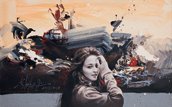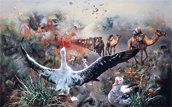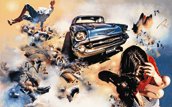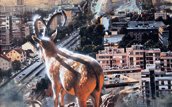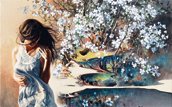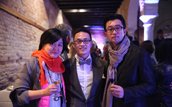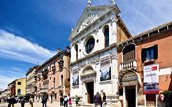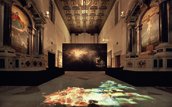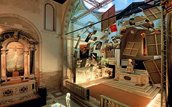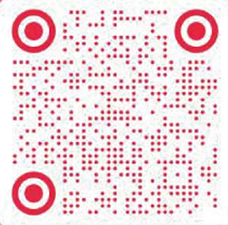Location: Chiesa Santa Maria Della Visitazione
The Universe of Unreality-2013 Zhong Biao’s Visions
Back
Duration: 2013.05.31 -- 2013.11.01
Location: Chiesa Santa Maria Della Visitazione
Location: Chiesa Santa Maria Della Visitazione
Exhibition Preface
The Universe of Unreality-2013 Zhong Biao’s Visions was unveiled in Chiesa Santa Maria Della Visitazione, Venice on May 31st, 2013. This major Chinese contemporary art project is held by Today Art Museum and Winshare Museum, assisted by Berengo Studio; it attracted nearly 500 guests from home and abroad to come-their enthusiastic response undoubtly heated up the whole scene, and even drove away the continuous drizzle in Venice. Speeches were given by Mrs. Suzhen Xie the director of Today Art Museum, Mr. Gary Xu the curator and the professor of University of Illinois, Mr. Zhong Biao the artist, and Mr. Adriano Berengo the director of Berengo Studio. The dinner party lasted from 19:00 to 22:30, after that guests were fetched by giant barges sent from Berengo Contemporary Art and Glass Museum to Murano Island, spending the whole night welcoming the period of this grand opening ceremony.
Mr. Wei Ding, the ambassador of Chinese Embassy in Italy, went to Santa Maria in advance on May 29th to watch the exhibition since he had to attend Chinese Pavillion’s opening ceremony in the afternoon. Later he went to other Chinese artists exhibition as well. This year, more voices of China have merged into the choir of Biennale.
Zhong Biao’s 84 works, along with the 68 original ancient paintings in the church, visions on the ground, sky screen on the dome and the aged celestial globe, formed as a whole to explore the universe of unreality. Believe it or not, even the bethel at the end of the church became a part of the exhibition. Pious disciples were long before waiting anxiously for this extraordinary Sunday to come.
It is a complex exhibition with clear arrangements. All the difficulties we met during the setting have been well placed out of visitors’ sight. It reveals only sharp and clear vision effects. Thanks to Venice’s highly developed exhibition economy due to its more than 100 years’ Biennale experience, our curator and local professional team have solved numerous problems and presented an exhibition without borders which was just like what we originally planned.
The Universe of Unreality tries to traverse contemporary conflicts between nations, societies, people and natural disasters by questioning the ultimate value. How can we face up to real problems? In Zhong Biao’s view, the hidden connections in vast universe is a real treasure house, for it has the exact answers we want. It provides the hint which is exactly the chance for humanbeings to surpass their own limits. By placing this kind of questioning in the church and merging the senses with ideas through art’s reconstruction, even common folks can easily grasp the real meaning that lies in the deep.
Walking into the dark church, you can spot the contents written on display panels are not arranged in the usual ways. Mr. Gary Xu, the curator, used 6 questions to replace the common introduction. 1. How do you view the changes in contemporary China’s politics, economy, culture and natural environments? 2. How can art care about politics without losing its original richness and complications of visions? 3. How does the “Revelation” displayed on both sides include all sorts of contradictions and developing trends of things? 4. What will happen if we view the earth from many light years’ distance? 5. Why does the artist project the video of Shangri-La sky onto the dome of the church? 6. Given the meaning of Shangri-La, “the sun and moon that lie in our hearts”, will there be new meanings added into the exhibition? These questions make visitors stop and think, which is a steppingstone for their following exhibition experience.
The huge sketch, Revelation, 3.5 m in height and 9 m in length, displayed on both sides of the walls, is filled with streams of consciousness changing without logics, concealing infinite possibilities. The 33 empty frames on the sketch represent the future waiting to become reality; while the 12 meters religious painting on the dome represents the remote past, which expands deeper into the church and guiding the visitors to come around the showboard and enter the middle section of the church accompanied by a beam of lights. There, when people turn their heads around, a huge painting named Light Year will jump into the sight and help answer the fourth question stated before. When we view the earth in many light years’ distance, we will know that many things that happened on earth have not really disappeared yet; they are just on their way to other distant planets. From this point of view, we can conclude that the past, present and the future of earth exist together in the sense of space. The Light Year explains this co-existence: the life emerging from the darkness, the changes of the galaxy, the explosion of the supernova...all of them make us feel tiny and in the meantime, vast. On the ground between the two shrines in the middle section of the church, a catchy video is projected: in misty fog there derives the form, just like the way of movements from energy world that creates the reality world via exiting the time and space. All the information of the macro, micro world, and the real world exchange and transverse with each other, forming multi-directional movements yet still fail to fend against the overall trend of going east. Therefore they melt into the universe. The beautiful sounds of nature is what we are sending towards the sky.
The following space is a dramatic present. Four projectors form a circle and cast the light on the dome of the church. The video of sky was shoot in Shangri-La, the closest place near the sky on the south of the Tibetan Plateau. It sublimates the whole scene. When the dome opens, we get to see the Shangri-La sky with casual movements of the clouds and stars; and at night, the video is changed into a virtual travel experience into the cosmos. Eighty-one paintings are like fragments falling from the sky, describing the hidden dynamic energy world, the unrest reality, along with quiet lights and daily scene, whispering that our suffering is nothing compared to the deeper spaces. Levitating pictures make visitors feel that time has stopped. The frozen time, as for Zhong Biao, is exactly what “the present” means: look outwards, there are the past and the future; look inward, there is permanent present without a trace of past or future. The St. Maria and Jesus in the shrine join with the pictures to take us away from the reality for now. Although time difference is still playing with our senses of space and delusions are conveying the information, there is no obstacle lies in between our inner connection with the universe of unreality. Just let your thoughts wonder.
People can walk under the Shangri-La sky with his/her own questions, clarifying the revelation and chaos, the past and the future, the reality and dream, and take as long as they want to feel why the above items are actually a whole. At this point, what we see might not be true, yet what we feel is by all means, solid.
Zhong Biao says: “When we are talking about not seeing through, we are referring to the connection lies in the deep of information pieces. Theatricality is an abundant and intact causality. If we can see through the fragments of reality and spot the complex inner connections that lie in the deep, if we can see the whole process of how the beginning affects the results, we can expect the theatricality. In the deepest place, the world and the universe is a united whole. Everything interacts with each other.”
In this over 500 years old church, Zhong Biao’s art integrated with Venice’s ancient wall paintings perfectly. Zhong Biao says: “Paintings and spaces are like lovers, they will get along very well if they are familiar with each other’s characteristics. They both have lives. Finding the way to cooperate can activate them in order to lighten up the life.” He managed to do that. Only very sensitive visitors from the west can deduce the fact that Zhong Biao comes from China via his name and fragments of information, which corresponds to his own words: People may have different cultural backgrounds, yet the heart has no boundaries.
Western visitors get to discuss more about the concepts of time and space, visible and invisible items. A male visitor from Brazil knows exactly the meaning of chaos represents the things that are going to happen, while an Italian young man knows the empty frames represent the thing to come.
By creating a live experience, the artist provides a rather convenient way for visitors to understand him. In the guest book there were people saying “I’ve never been to such an thoughtful exhibition! It’s thrilling. Thank you very much.” In the opening speech, the chief of Venice Cultural Protection Committee and the founder of Berengo Studio have brought up several times the praise toward this exhibition’s respect to the church and its tailored design.
Daniel Wagner from Associated Press wrote on his Facebook that “This is just my luck to have witnessed the most beautiful and creative exhibition in 2013 Biennale!” Zhong Biao has successfully broken the limits of past and future, home and abroad for he views them as a whole without limits at all.
Among so many feedbacks from the visitors, most of them were not “congratulations” but “thank you”; for congratulations means you have got it while thank you means you have given the visitors something therefore they want to express the gratitude. This magnificent, complicated exhibition is the result of our group and partners diligent work and support. In order to provide everything at its best, we even brought a Chinese chef with us, just to make sure proper seasoning and food will be well provided.
Being a highbrow in one’s field is surely the evidence of his professionalism. However, presenting the original meaning which only the minority can understand to the masses of people without degrading the works, that is called the feast of all walks of life, and is truly a contribution.
Santa Maria Church faces toward the Venice Canal-a branch that eventually goes into the sea. The church wears two vertical posters on her sides, representing “the Universe of Unreality” on Zattere, waiting for thousands of people per day to pay their visit. Even in the first closing day-Monday-a great amount of anxious audiences are still waiting outside to come in. Zhong Biao hopes more people will begin to search the hidden relationship of the universe, discover deep secrets in reality so as to traverse their limitations and integrate into the nature and the cosmos as a whole.
In this world, there is a continuous system of meanings which connects with the form of the solid world. The system is like electricity-it has no forms. And artworks are like electrical equipments while artistic language is the plug and wire. By attaching the plug and wire (artistic language) onto the net of electricity (the system of meanings), the electrical equipments (artworks) can start to function.
“The Universe of Unreality-2013 Zhong Biao’s Visions” is a perfect combination of eastern contemporary art and western classical architecture. It is also the reflection and practice of artist Zhong Biao using artistic language to traverse place and cultures. It is the first attempt for Santa Maria Church to embracing contemporary art in her arms. We believe there’ll be revelations happened everywhere, at any time, with or without any purpose during the whole exhibition period before the closing day on Oct.27. People will come, then they might take away or bring their own “sun and moon in the heart”-their own Shangri-La.
Mr. Wei Ding, the ambassador of Chinese Embassy in Italy, went to Santa Maria in advance on May 29th to watch the exhibition since he had to attend Chinese Pavillion’s opening ceremony in the afternoon. Later he went to other Chinese artists exhibition as well. This year, more voices of China have merged into the choir of Biennale.
Zhong Biao’s 84 works, along with the 68 original ancient paintings in the church, visions on the ground, sky screen on the dome and the aged celestial globe, formed as a whole to explore the universe of unreality. Believe it or not, even the bethel at the end of the church became a part of the exhibition. Pious disciples were long before waiting anxiously for this extraordinary Sunday to come.
It is a complex exhibition with clear arrangements. All the difficulties we met during the setting have been well placed out of visitors’ sight. It reveals only sharp and clear vision effects. Thanks to Venice’s highly developed exhibition economy due to its more than 100 years’ Biennale experience, our curator and local professional team have solved numerous problems and presented an exhibition without borders which was just like what we originally planned.
The Universe of Unreality tries to traverse contemporary conflicts between nations, societies, people and natural disasters by questioning the ultimate value. How can we face up to real problems? In Zhong Biao’s view, the hidden connections in vast universe is a real treasure house, for it has the exact answers we want. It provides the hint which is exactly the chance for humanbeings to surpass their own limits. By placing this kind of questioning in the church and merging the senses with ideas through art’s reconstruction, even common folks can easily grasp the real meaning that lies in the deep.
Walking into the dark church, you can spot the contents written on display panels are not arranged in the usual ways. Mr. Gary Xu, the curator, used 6 questions to replace the common introduction. 1. How do you view the changes in contemporary China’s politics, economy, culture and natural environments? 2. How can art care about politics without losing its original richness and complications of visions? 3. How does the “Revelation” displayed on both sides include all sorts of contradictions and developing trends of things? 4. What will happen if we view the earth from many light years’ distance? 5. Why does the artist project the video of Shangri-La sky onto the dome of the church? 6. Given the meaning of Shangri-La, “the sun and moon that lie in our hearts”, will there be new meanings added into the exhibition? These questions make visitors stop and think, which is a steppingstone for their following exhibition experience.
The huge sketch, Revelation, 3.5 m in height and 9 m in length, displayed on both sides of the walls, is filled with streams of consciousness changing without logics, concealing infinite possibilities. The 33 empty frames on the sketch represent the future waiting to become reality; while the 12 meters religious painting on the dome represents the remote past, which expands deeper into the church and guiding the visitors to come around the showboard and enter the middle section of the church accompanied by a beam of lights. There, when people turn their heads around, a huge painting named Light Year will jump into the sight and help answer the fourth question stated before. When we view the earth in many light years’ distance, we will know that many things that happened on earth have not really disappeared yet; they are just on their way to other distant planets. From this point of view, we can conclude that the past, present and the future of earth exist together in the sense of space. The Light Year explains this co-existence: the life emerging from the darkness, the changes of the galaxy, the explosion of the supernova...all of them make us feel tiny and in the meantime, vast. On the ground between the two shrines in the middle section of the church, a catchy video is projected: in misty fog there derives the form, just like the way of movements from energy world that creates the reality world via exiting the time and space. All the information of the macro, micro world, and the real world exchange and transverse with each other, forming multi-directional movements yet still fail to fend against the overall trend of going east. Therefore they melt into the universe. The beautiful sounds of nature is what we are sending towards the sky.
The following space is a dramatic present. Four projectors form a circle and cast the light on the dome of the church. The video of sky was shoot in Shangri-La, the closest place near the sky on the south of the Tibetan Plateau. It sublimates the whole scene. When the dome opens, we get to see the Shangri-La sky with casual movements of the clouds and stars; and at night, the video is changed into a virtual travel experience into the cosmos. Eighty-one paintings are like fragments falling from the sky, describing the hidden dynamic energy world, the unrest reality, along with quiet lights and daily scene, whispering that our suffering is nothing compared to the deeper spaces. Levitating pictures make visitors feel that time has stopped. The frozen time, as for Zhong Biao, is exactly what “the present” means: look outwards, there are the past and the future; look inward, there is permanent present without a trace of past or future. The St. Maria and Jesus in the shrine join with the pictures to take us away from the reality for now. Although time difference is still playing with our senses of space and delusions are conveying the information, there is no obstacle lies in between our inner connection with the universe of unreality. Just let your thoughts wonder.
People can walk under the Shangri-La sky with his/her own questions, clarifying the revelation and chaos, the past and the future, the reality and dream, and take as long as they want to feel why the above items are actually a whole. At this point, what we see might not be true, yet what we feel is by all means, solid.
Zhong Biao says: “When we are talking about not seeing through, we are referring to the connection lies in the deep of information pieces. Theatricality is an abundant and intact causality. If we can see through the fragments of reality and spot the complex inner connections that lie in the deep, if we can see the whole process of how the beginning affects the results, we can expect the theatricality. In the deepest place, the world and the universe is a united whole. Everything interacts with each other.”
In this over 500 years old church, Zhong Biao’s art integrated with Venice’s ancient wall paintings perfectly. Zhong Biao says: “Paintings and spaces are like lovers, they will get along very well if they are familiar with each other’s characteristics. They both have lives. Finding the way to cooperate can activate them in order to lighten up the life.” He managed to do that. Only very sensitive visitors from the west can deduce the fact that Zhong Biao comes from China via his name and fragments of information, which corresponds to his own words: People may have different cultural backgrounds, yet the heart has no boundaries.
Western visitors get to discuss more about the concepts of time and space, visible and invisible items. A male visitor from Brazil knows exactly the meaning of chaos represents the things that are going to happen, while an Italian young man knows the empty frames represent the thing to come.
By creating a live experience, the artist provides a rather convenient way for visitors to understand him. In the guest book there were people saying “I’ve never been to such an thoughtful exhibition! It’s thrilling. Thank you very much.” In the opening speech, the chief of Venice Cultural Protection Committee and the founder of Berengo Studio have brought up several times the praise toward this exhibition’s respect to the church and its tailored design.
Daniel Wagner from Associated Press wrote on his Facebook that “This is just my luck to have witnessed the most beautiful and creative exhibition in 2013 Biennale!” Zhong Biao has successfully broken the limits of past and future, home and abroad for he views them as a whole without limits at all.
Among so many feedbacks from the visitors, most of them were not “congratulations” but “thank you”; for congratulations means you have got it while thank you means you have given the visitors something therefore they want to express the gratitude. This magnificent, complicated exhibition is the result of our group and partners diligent work and support. In order to provide everything at its best, we even brought a Chinese chef with us, just to make sure proper seasoning and food will be well provided.
Being a highbrow in one’s field is surely the evidence of his professionalism. However, presenting the original meaning which only the minority can understand to the masses of people without degrading the works, that is called the feast of all walks of life, and is truly a contribution.
Santa Maria Church faces toward the Venice Canal-a branch that eventually goes into the sea. The church wears two vertical posters on her sides, representing “the Universe of Unreality” on Zattere, waiting for thousands of people per day to pay their visit. Even in the first closing day-Monday-a great amount of anxious audiences are still waiting outside to come in. Zhong Biao hopes more people will begin to search the hidden relationship of the universe, discover deep secrets in reality so as to traverse their limitations and integrate into the nature and the cosmos as a whole.
In this world, there is a continuous system of meanings which connects with the form of the solid world. The system is like electricity-it has no forms. And artworks are like electrical equipments while artistic language is the plug and wire. By attaching the plug and wire (artistic language) onto the net of electricity (the system of meanings), the electrical equipments (artworks) can start to function.
“The Universe of Unreality-2013 Zhong Biao’s Visions” is a perfect combination of eastern contemporary art and western classical architecture. It is also the reflection and practice of artist Zhong Biao using artistic language to traverse place and cultures. It is the first attempt for Santa Maria Church to embracing contemporary art in her arms. We believe there’ll be revelations happened everywhere, at any time, with or without any purpose during the whole exhibition period before the closing day on Oct.27. People will come, then they might take away or bring their own “sun and moon in the heart”-their own Shangri-La.
Curator
Xu Gang
Artist
Zhong Biao

 Zhiguan: Wang Zimu Art Exhibition
Zhiguan: Wang Zimu Art Exhibition Seasons of Cezanne The Immersive Experience
Seasons of Cezanne The Immersive Experience Marie de Villein: Behind the Sun
Marie de Villein: Behind the Sun “一粒一世界——北京大学颗粒艺术展”
“一粒一世界——北京大学颗粒艺术展”
 Florentijn Hofman :Celebrate!
Florentijn Hofman :Celebrate! Li Nu: As if Sand Were Stone
Li Nu: As if Sand Were Stone Exhibition customization course | TIM YIP MIRROR children's art class
Exhibition customization course | TIM YIP MIRROR children's art class
 TAM Open Studio / Hello, New Friends
TAM Open Studio / Hello, New Friends WANG SHIKUO/TODAY ART MUSEUM YOUNG ARTIST RESIDENCY IN NEW YORK CITY
WANG SHIKUO/TODAY ART MUSEUM YOUNG ARTIST RESIDENCY IN NEW YORK CITY 2018 third wang shikuo award -- nomination exhibition of contemporary young artists
2018 third wang shikuo award -- nomination exhibition of contemporary young artists

